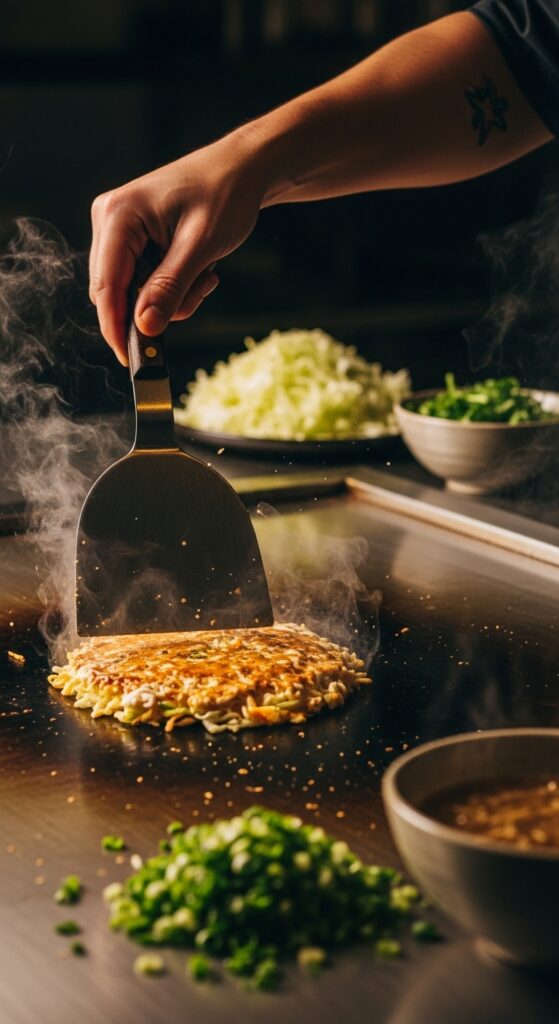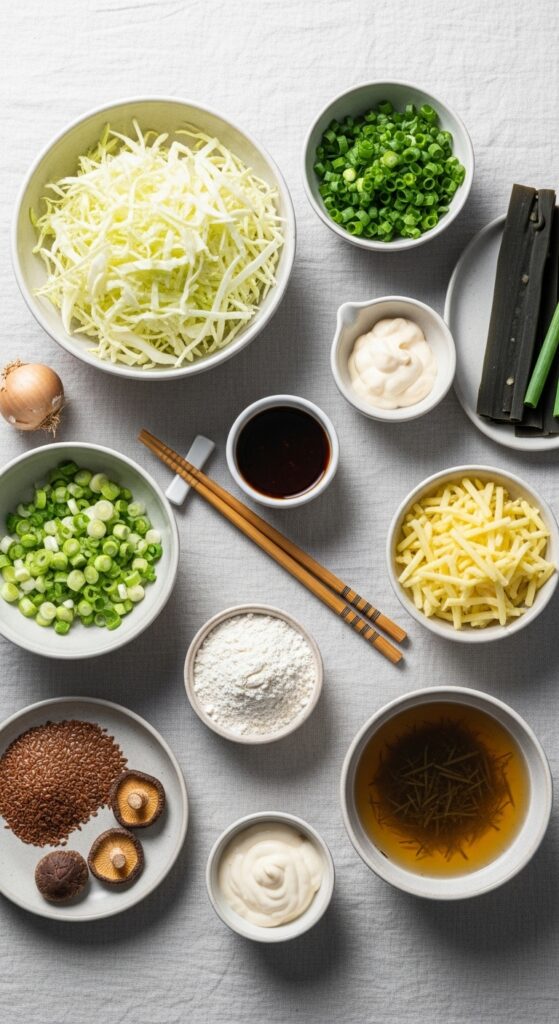There’s something magical about watching okonomiyaki sizzle on a hot griddle—the batter bubbling, the cabbage softening, the surface caramelizing into a golden crust. In Osaka, this is more than food. It’s a ritual, a comforting, communal experience. And the best part? You can make this iconic Japanese street food completely plant-based, without losing any of its soul.
So, grab your spatula. We’re making Osaka-style vegan okonomiyaki—a savory pancake dream layered with umami from vegan dashi, a cloud-like batter, and all the crispy edges you crave.

A Little Story First
The first time I had okonomiyaki was at a small Osaka stall—two stools, one griddle, and an old radio humming enka songs. The cook poured a ladle of batter, tossed in heaps of shredded cabbage, cracked an egg over it, and flipped it with a flick of the wrist that made me gasp. It was artistry.
When I went vegan years later, I missed that texture and flavor—the smoky-sweet sauce, the creamy interior, that hint of ocean from dashi. It took a while, but this version gets startlingly close. Close enough that if you close your eyes, you can almost hear the chatter of an Osaka night.
Why It’s Special

This isn’t just another vegan pancake. It’s a love letter to Osaka’s street food culture.
Okonomiyaki translates loosely to “as you like it grilled.” It’s endlessly customizable—meat, seafood, cabbage, noodles, whatever you fancy. The Osaka version, though, has its own rhythm: cabbage-heavy batter, all mixed together before grilling (unlike Hiroshima-style, where layers rule).
The vegan twist here doesn’t just mimic—it innovates. Instead of eggs, we use a silky mix of flaxseed and water for binding. Instead of bonito flakes in the dashi, we craft a deeply savory broth from kombu (kelp) and shiitake mushrooms. The result? Every bite hums with umami.
It’s comforting, deeply flavorful, and totally plant-based. The kind of meal that makes even non-vegans go quiet for a minute while they chew.
Ingredients & Substitutions

Making Osaka-style vegan okonomiyaki starts with respect for the basics—but also a little flexibility.
The Core Ingredients
- All-purpose flour (1 cup) – Classic base. You can use whole wheat for a nuttier edge, but it’ll be denser.
- Vegan dashi (1 cup) – The backbone of flavor. Made from dried shiitake and kombu, it adds a savory oceanic whisper.
- Flaxseed meal (1 tbsp) + 2.5 tbsp water – Our vegan “egg.” Binds everything beautifully.
- Cabbage (2 cups, finely shredded) – Sweet, crunchy, essential. Don’t skip or skimp.
- Green onions (3, finely chopped) – Add brightness and mild sharpness.
- Grated nagaimo or potato (2 tbsp) – Gives that fluffy interior Osaka okonomiyaki is known for.
- Salt (½ tsp) – Brings balance.
- Oil for frying (neutral oil like grapeseed or avocado) – Keeps it crisp, not greasy.
The Flavor Finishers
- Vegan okonomiyaki sauce – You can buy it, but homemade (a mix of vegan Worcestershire, ketchup, soy sauce, and a dash of sugar) is next-level.
- Vegan mayonnaise – Creamy counterpoint to the sweet-savory sauce.
- Nori flakes or aonori – That earthy sea-scented garnish.
- Pickled ginger (beni shoga) – Adds a pop of tang that cuts through richness.
- Optional: Vegan “bacon” bits or tofu cubes – For texture contrast and protein.
Substitutions
- No flaxseed? Use chia seeds in the same ratio.
- Can’t find kombu? Try a small piece of dried seaweed or a touch of white miso in your dashi for depth.
- Gluten-free? Substitute flour with chickpea flour or a 1:1 gluten-free blend.
- No nagaimo? Grated potato or even mashed tofu works surprisingly well.
Ingredient Tips
Shred the cabbage fine, almost like confetti. It ensures even cooking and that signature tender crunch. And if you can, let your batter rest 15 minutes before cooking—hydration equals better texture.
Step-by-Step Instructions

Alright, apron on. Let’s make magic.
Step 1: Make the Vegan Dashi
Soak 1 dried shiitake and a small piece of kombu in 2 cups water for 30 minutes. Gently heat (don’t boil) for 10 minutes, then remove solids. You’ll be left with a light amber broth that smells faintly of the sea. This is your umami gold.
Step 2: Prepare the Flax “Egg”
Mix flaxseed meal and water in a small bowl. Let it thicken for about 5–10 minutes—it should look gelatinous and slightly goopy (in the best way).
Step 3: Mix the Batter
In a large bowl, whisk flour, salt, and vegan dashi. Stir in grated nagaimo (or potato), flax mixture, cabbage, and green onions. Fold gently until just combined. Overmixing kills the fluff.
Step 4: Heat and Pour
Warm a non-stick pan or griddle over medium heat. Brush lightly with oil. Scoop about a cup of batter onto the pan and shape into a thick, round pancake, about 6 inches wide.
Step 5: Cook Patiently
Cook for about 4–5 minutes per side. Don’t rush the flip—wait until the edges turn golden and crisp. Then, using two spatulas (or one big one and courage), flip it. The second side cooks faster.
Step 6: Sauce It Up
Once both sides are crisp and the center is set, move it to a plate. Slather with okonomiyaki sauce, zigzag vegan mayo on top, sprinkle nori flakes, and add pickled ginger.
Step 7: Eat Immediately
This is not a wait-around dish. The magic lives in that just-grilled moment—hot, crisp, smoky.
👉 Recipe Card
Osaka-Style Vegan Okonomiyaki with Vegan Dashi
Prep time: 20 min
Cook time: 15 min
Total: 35 min
Servings: 2 large pancakes
Calories: ~290 per serving
Ingredients
- 1 cup all-purpose flour
- 1 cup vegan dashi
- 1 tbsp flaxseed meal + 2.5 tbsp water
- 2 cups finely shredded cabbage
- 3 green onions, chopped
- 2 tbsp grated nagaimo or potato
- ½ tsp salt
- 2 tbsp oil for frying
For topping:
- Vegan okonomiyaki sauce
- Vegan mayo
- Nori flakes
- Pickled ginger
Instructions
- Prepare vegan dashi by soaking kombu and shiitake, then heating gently.
- Mix flaxseed and water, let gel.
- In a bowl, whisk flour, salt, and dashi. Stir in cabbage, green onions, grated potato, and flax mix.
- Heat pan with oil. Scoop batter, shape into pancake.
- Cook 4–5 minutes each side, flipping carefully.
- Top with sauces and garnishes. Serve hot.
Cooking Techniques & Science

Why all this fuss over dashi? Because it’s the soul of umami. Traditional okonomiyaki relies on bonito flakes for that deep, savory punch. In vegan cooking, we mimic it through glutamates in mushrooms and seaweed. Kombu is rich in natural glutamic acid, while shiitake brings guanylate—together they amplify each other, creating depth that surprises even skeptics.
The grated nagaimo (or potato) isn’t just filler—it adds starch and moisture, giving the pancake its dreamy, slightly bouncy texture. It’s what makes Osaka-style okonomiyaki different from a plain veggie pancake.
As for flipping—this is an art. You’re looking for the “griddle timing”: when the surface goes matte, the edges firm up, and small bubbles appear. That’s your cue.
Use a flat spatula with a thin edge. Too thick, and you’ll tear it. Too early, and you’ll splatter batter everywhere (been there).
Cooking on a teppan or cast iron griddle is ideal, but a non-stick pan works fine if you keep the heat steady.
Serving & Pairing Suggestions

There’s no wrong way to eat okonomiyaki, but here’s how to make it shine.
Slice it like a pizza and serve with chopsticks or a fork—no rules here. The sauce-mayo combo should be messy, drippy, unapologetic.
Pair it with:
- A cold Japanese beer (Asahi or Sapporo, if you drink).
- Green tea or chilled barley tea for something sober but satisfying.
- A light miso soup or cucumber sunomono (vinegar salad) on the side for balance.
Want to make it fancier? Stack two pancakes with a layer of sautéed tofu or vegan kimchi in between—an okonomiyaki “sandwich.”
Conclusion
This Osaka-style vegan okonomiyaki with vegan dashi is more than just a plant-based twist on a Japanese classic—it’s a sensory memory recreated. The crunch of cabbage, the silky batter, the bold sauce—it’s proof that comfort food can evolve without compromise.
Whether you’re cooking for yourself or flipping pancakes for a crowd, this dish turns a simple night in into something a bit electric.
And once you’ve got the base down, the variations are endless. Add corn for sweetness, kimchi for funk, or smoked tofu for chew. Make it your own—after all, okonomi literally means “as you like it.”
So grab that spatula and cook up a little Osaka street magic in your kitchen tonight.
FAQs
1. Can I make the batter ahead of time?
Yes, but keep the cabbage separate until you’re ready to cook. The salt and moisture from the batter will make it soggy if it sits too long.
2. What’s the best way to flip okonomiyaki without breaking it?
Use a wide, flat spatula and let the first side cook fully before flipping—about 4–5 minutes. If it feels too soft, give it another minute. Patience pays off.
3. Can I freeze leftovers?
Absolutely. Let them cool, wrap individually, and freeze. Reheat in a skillet or oven, not the microwave (you’ll lose the crisp).
4. How do I make the okonomiyaki sauce at home?
Mix 2 tbsp ketchup, 1 tbsp vegan Worcestershire, 1 tbsp soy sauce, and ½ tsp sugar. Adjust sweetness to taste.
5. What if I don’t have vegan mayo?
Try cashew cream or a drizzle of tahini-lemon sauce—it won’t be traditional, but still delicious.
crispy edge, soft center, and layers of umami—that’s the Osaka pancake dream. And now, it’s yours to flip.

Selena is an experienced lifestyle blogger and the voice behind many of Cozy Toned’s inspiring posts. With a passion for mindful living, home styling, and everyday wellness, she shares practical tips and fresh ideas to help readers live beautifully and intentionally.